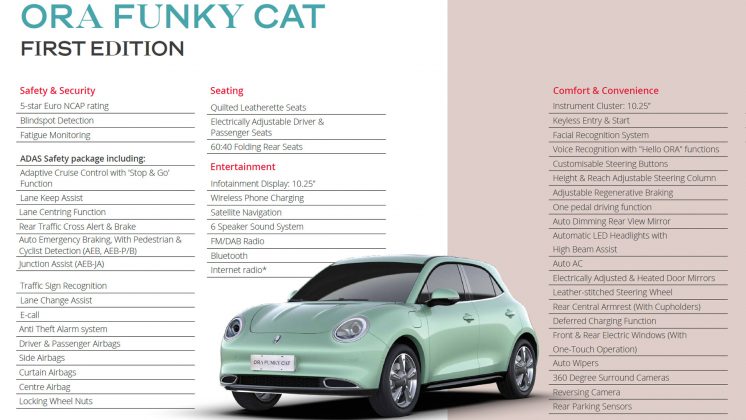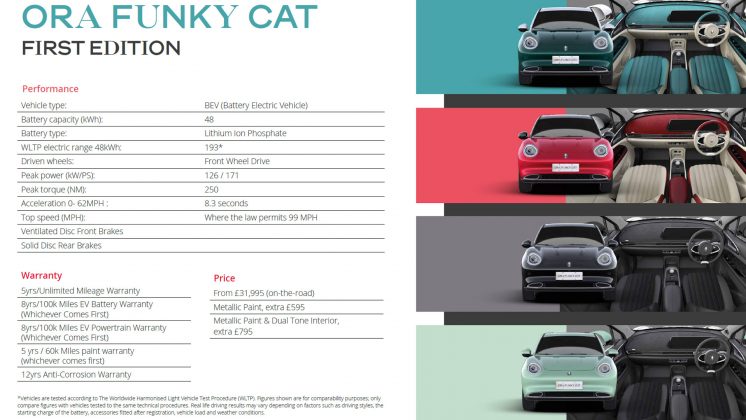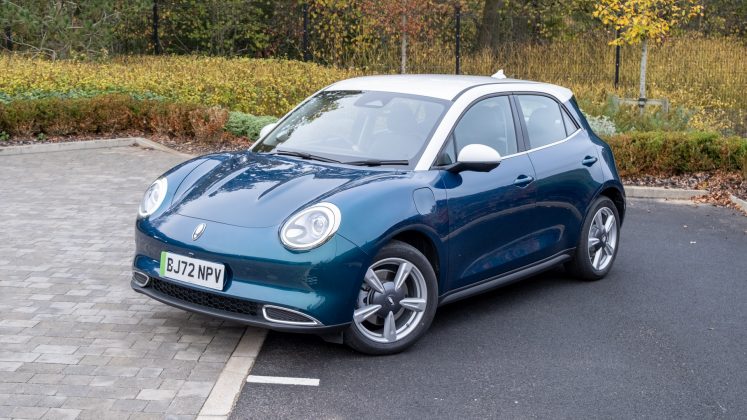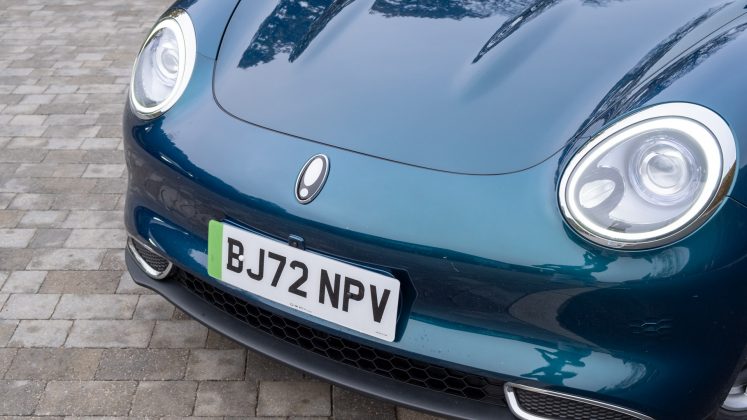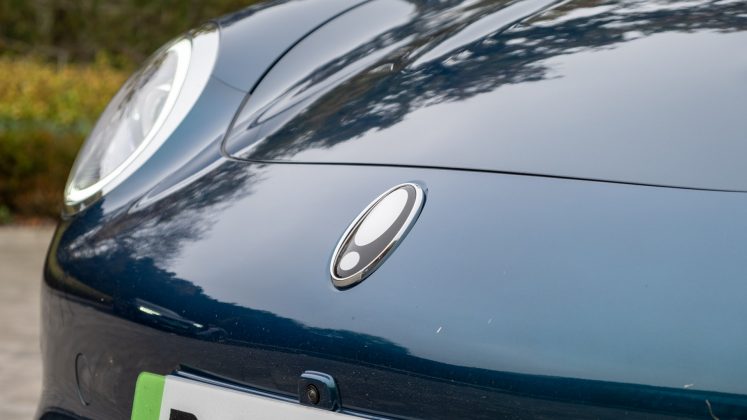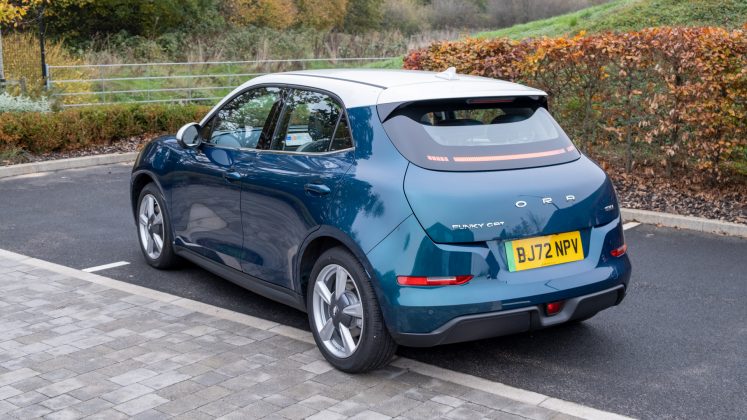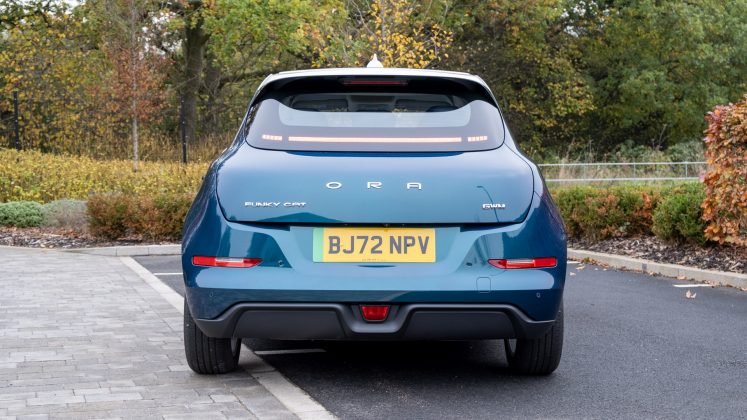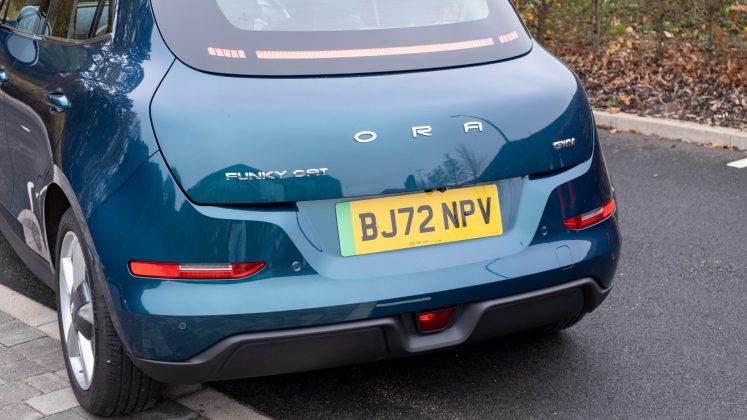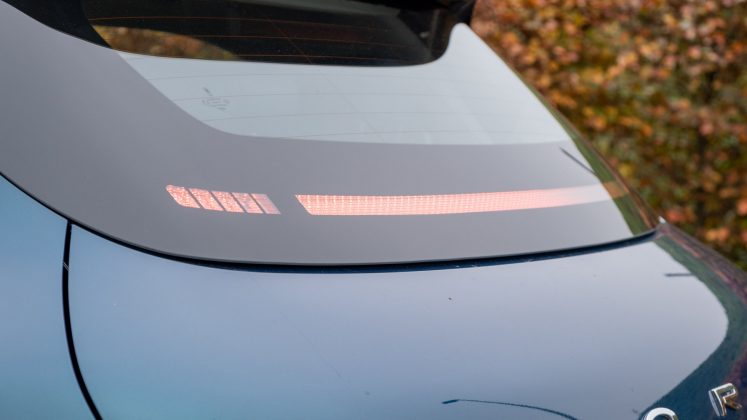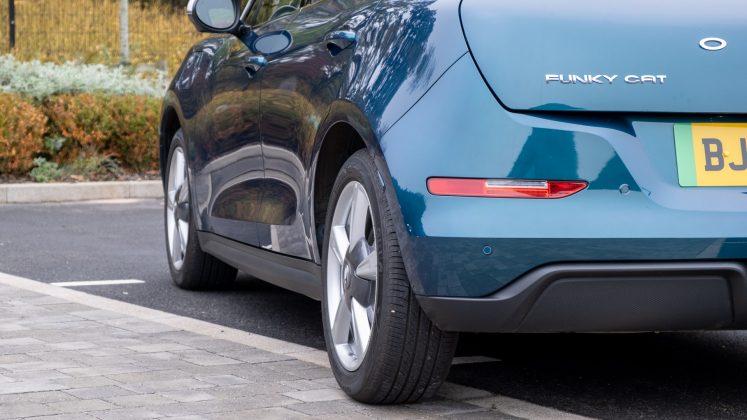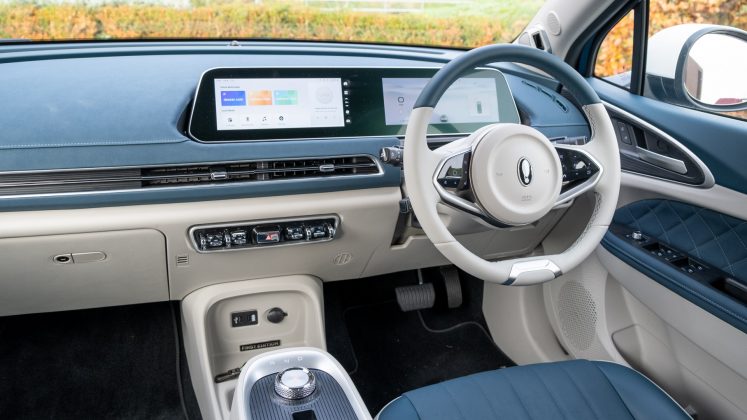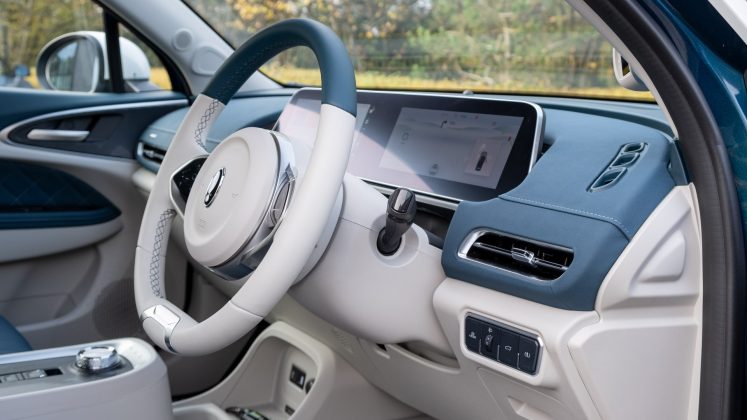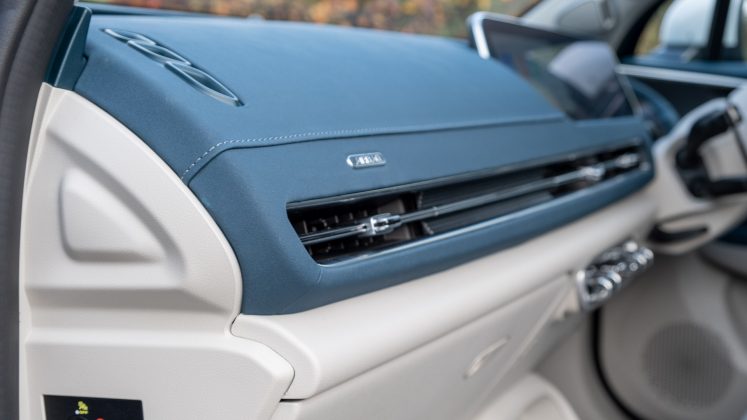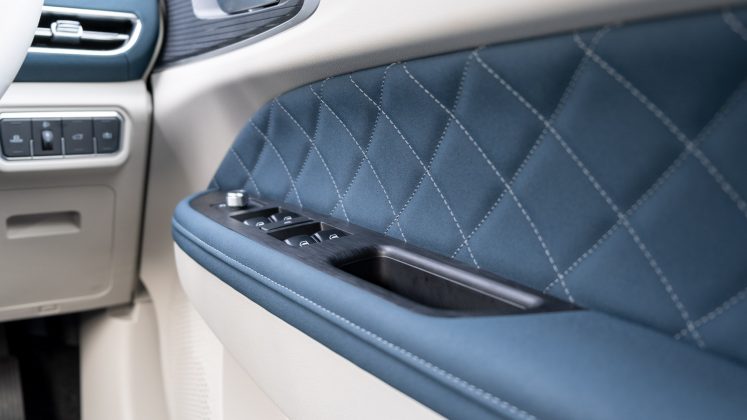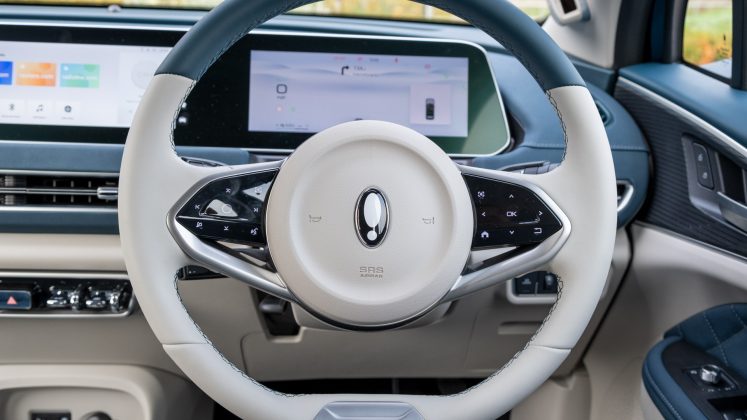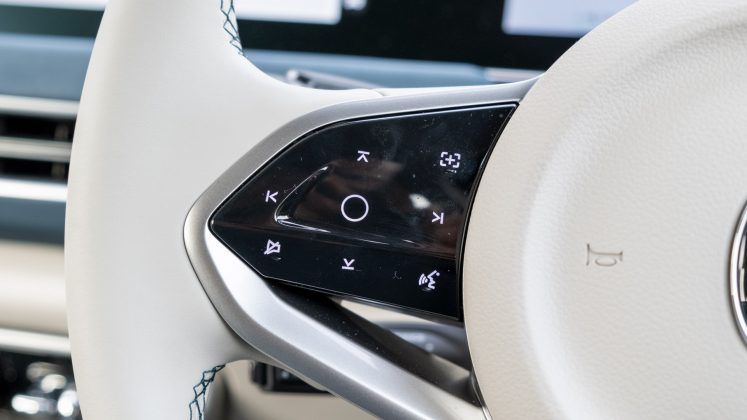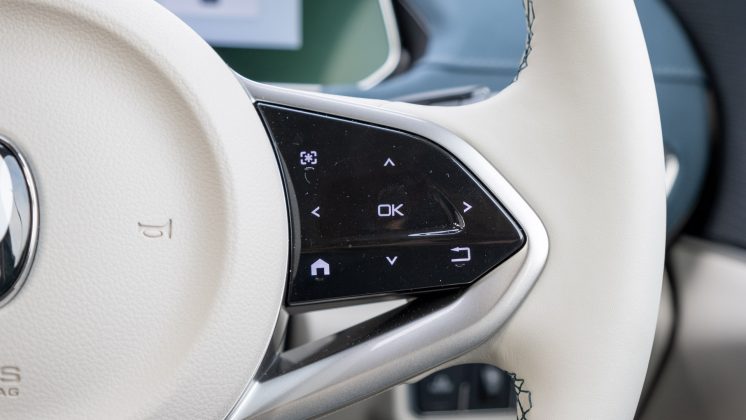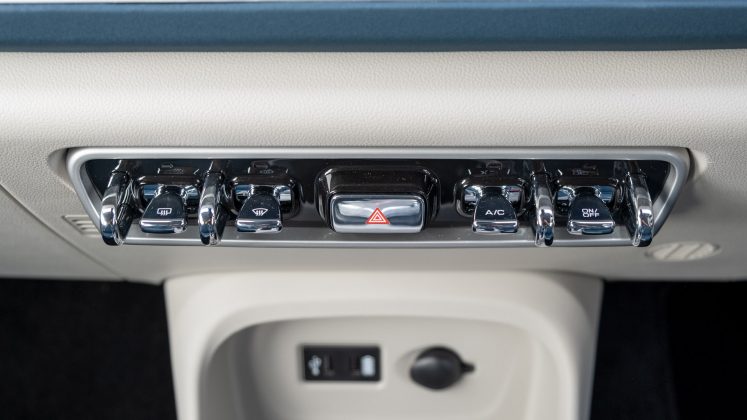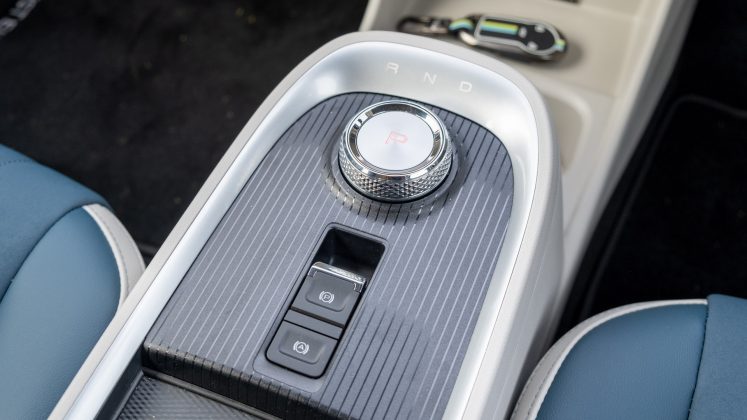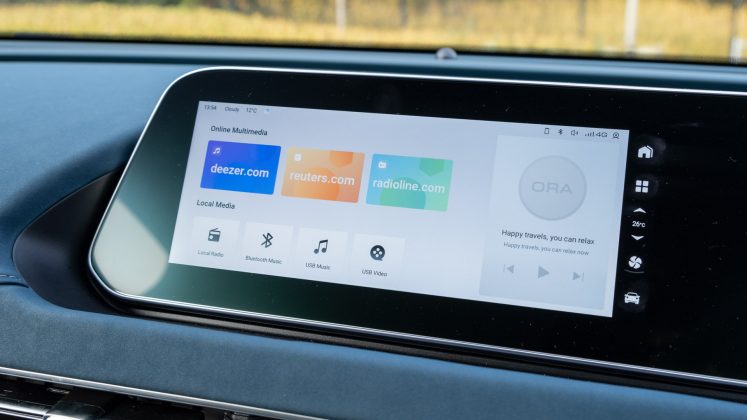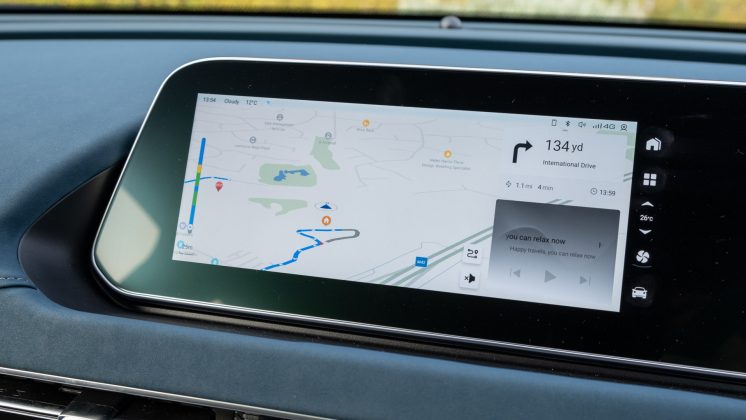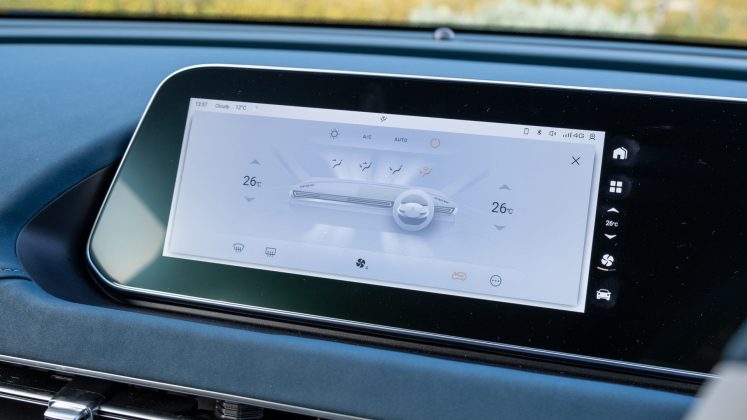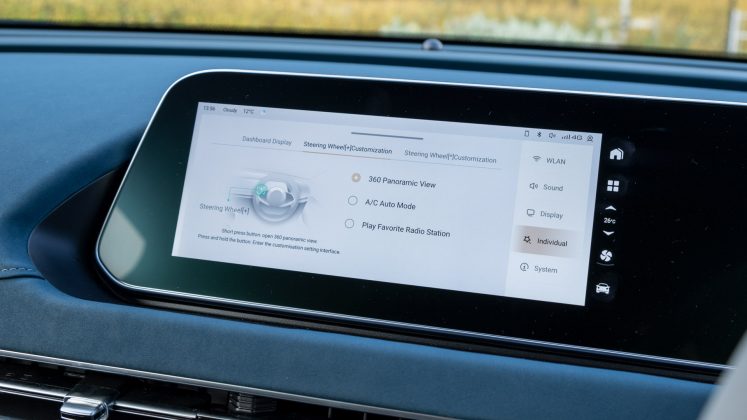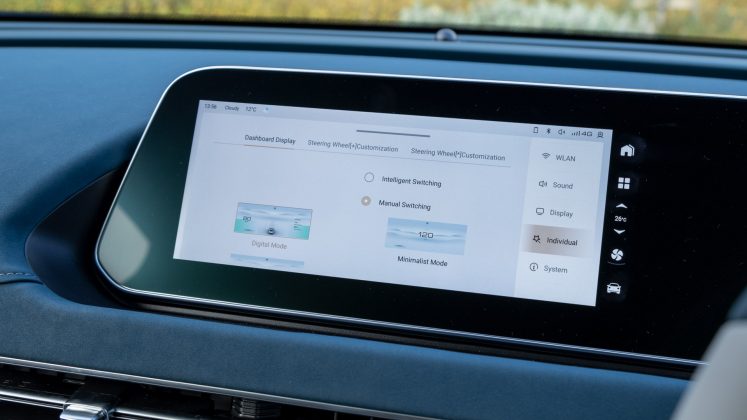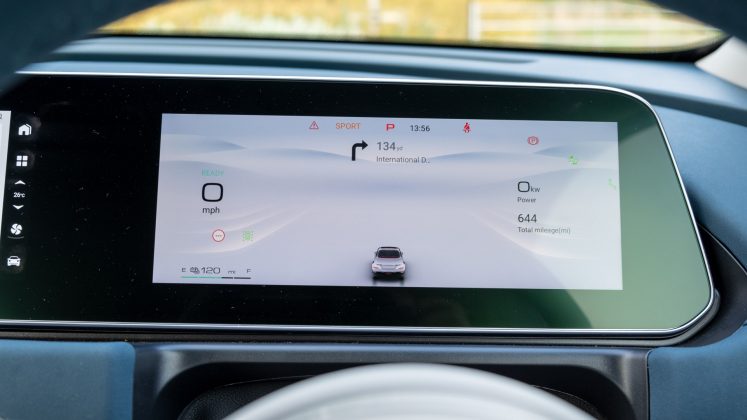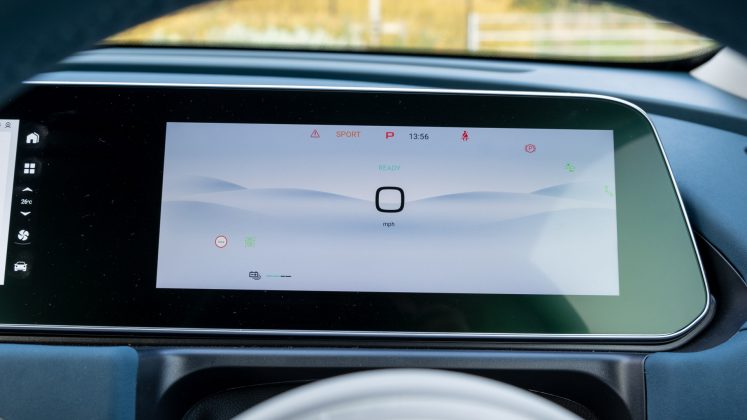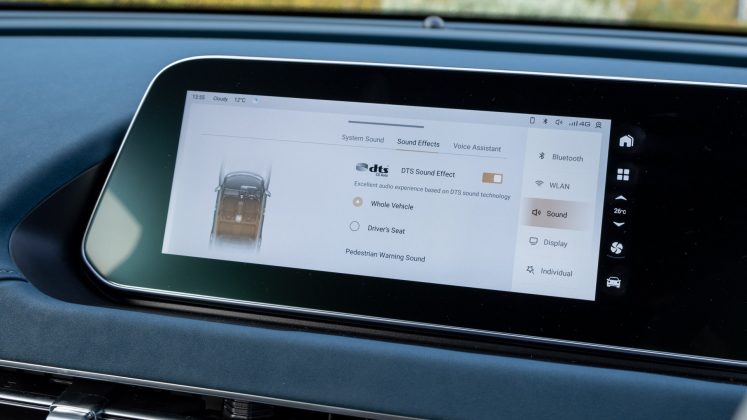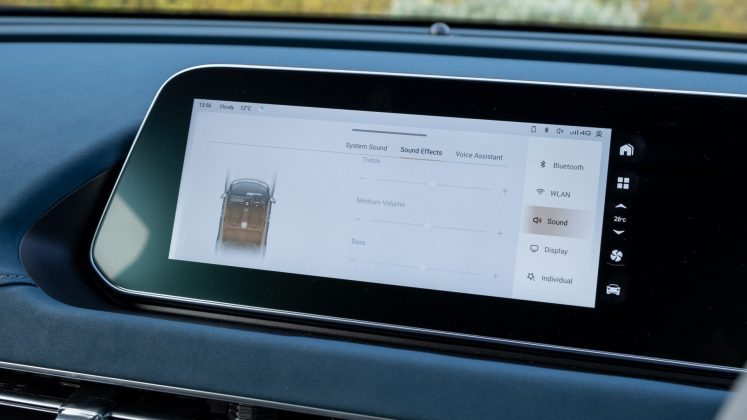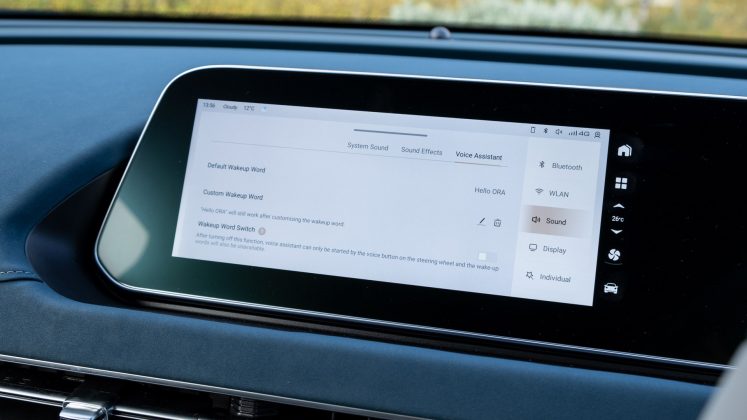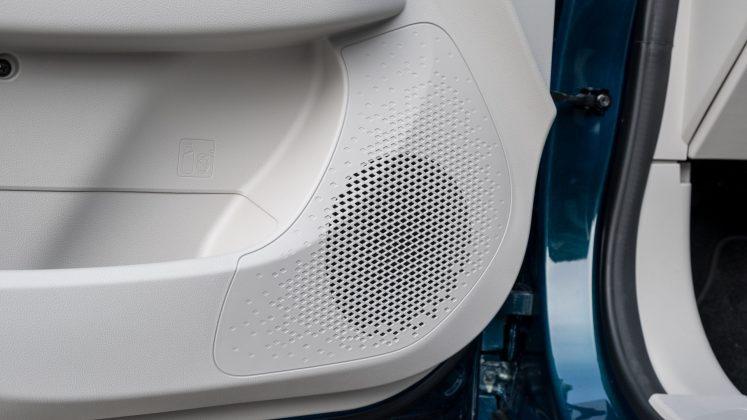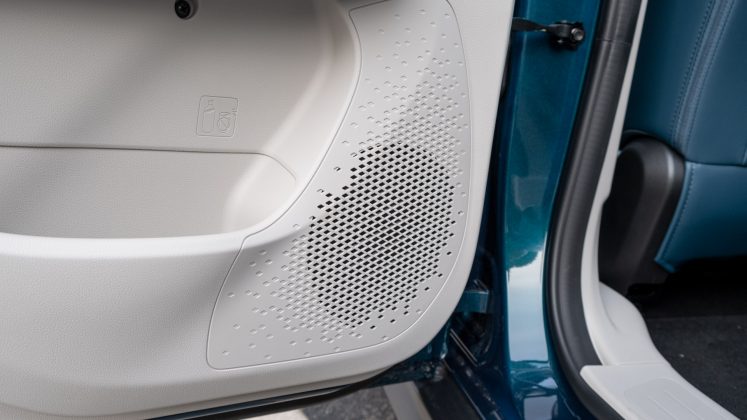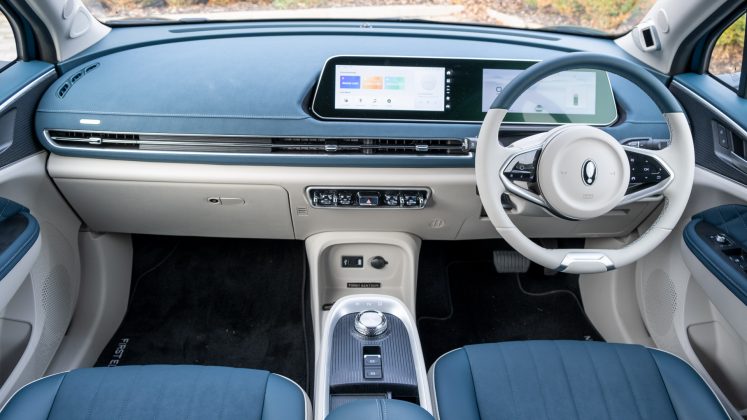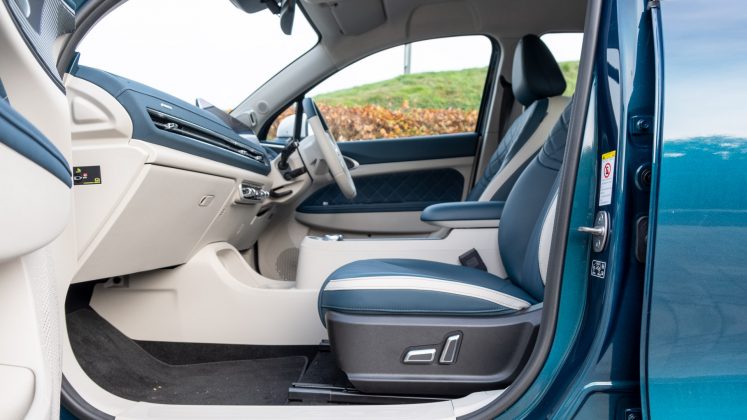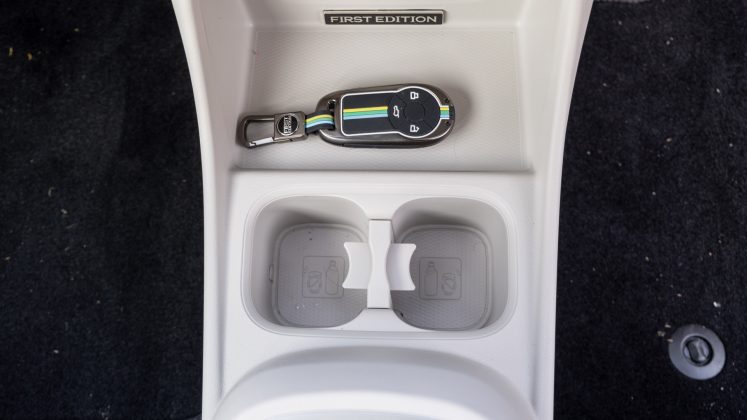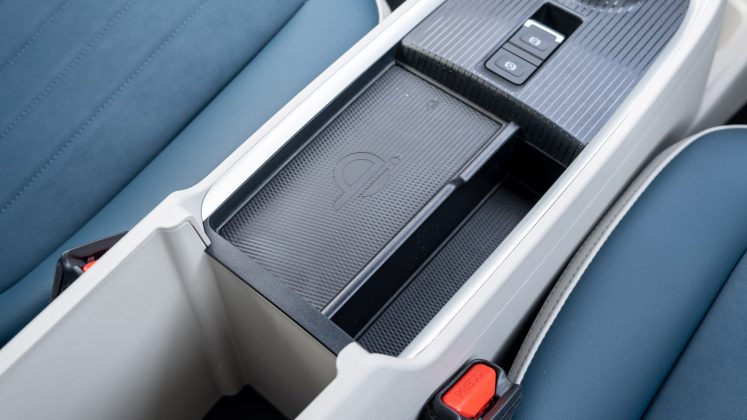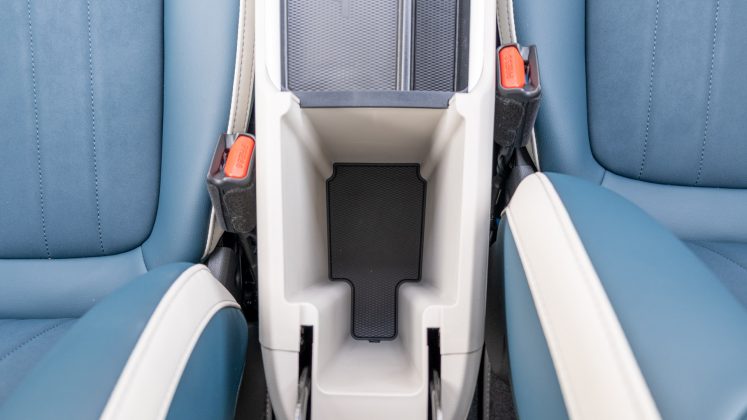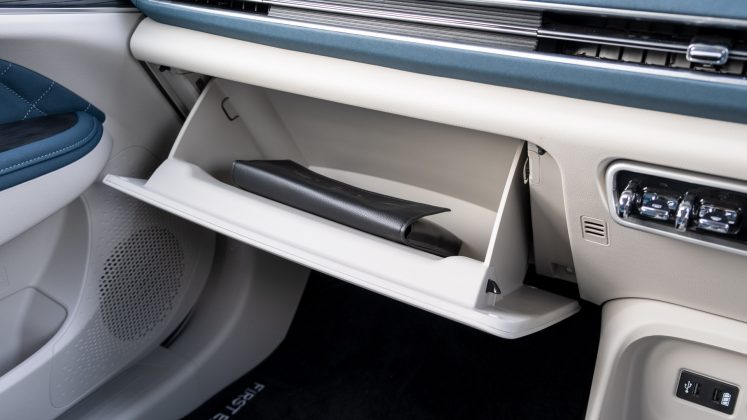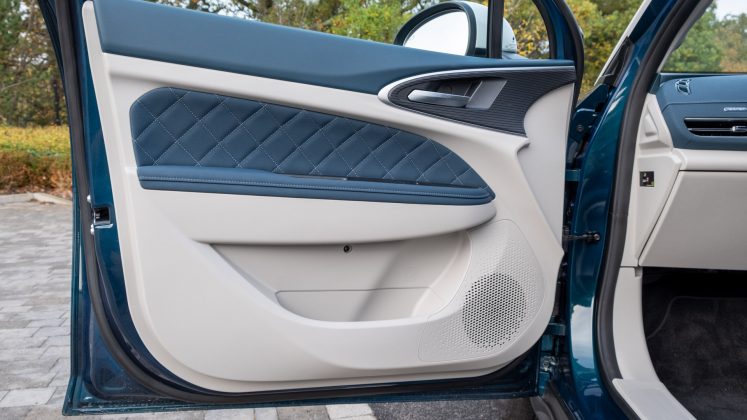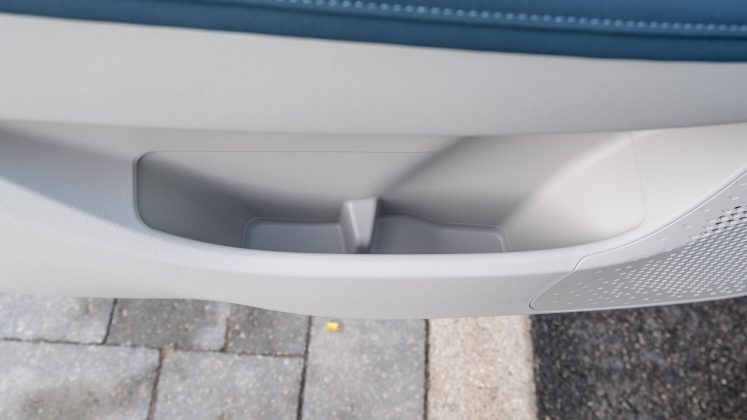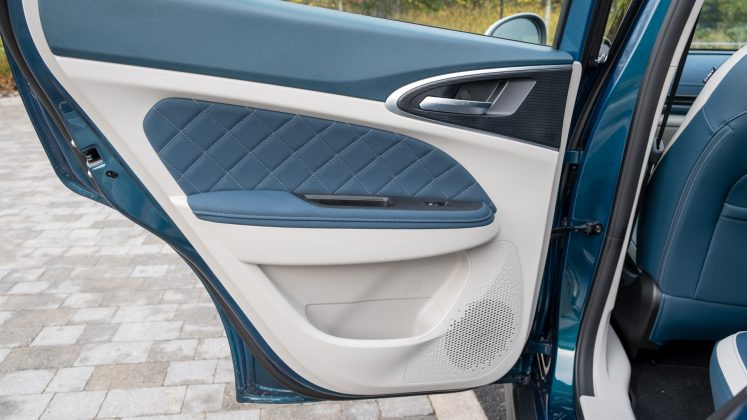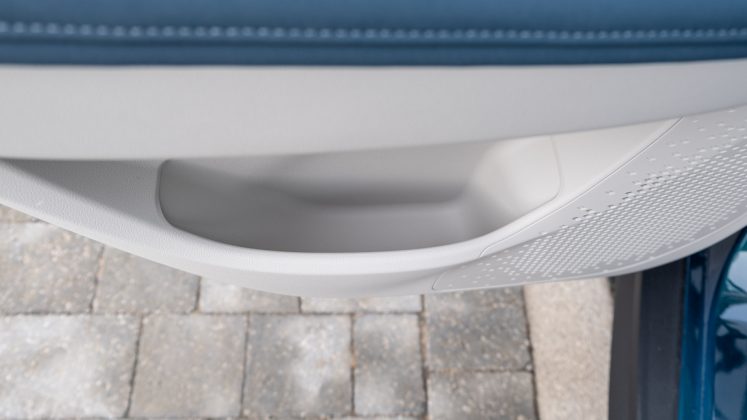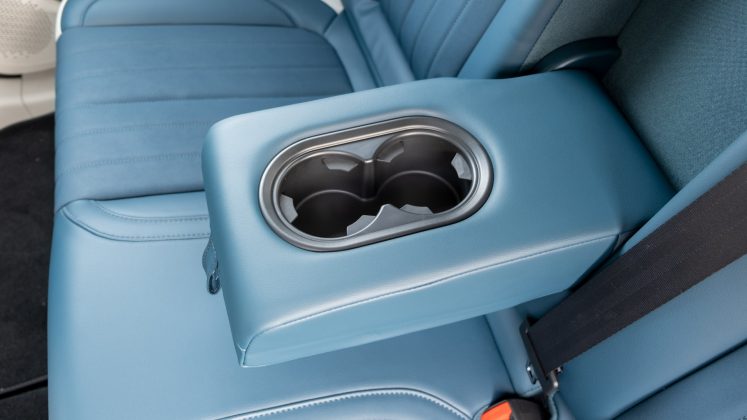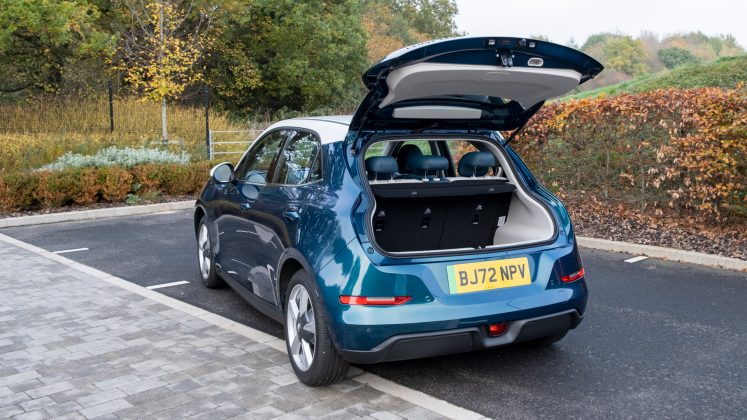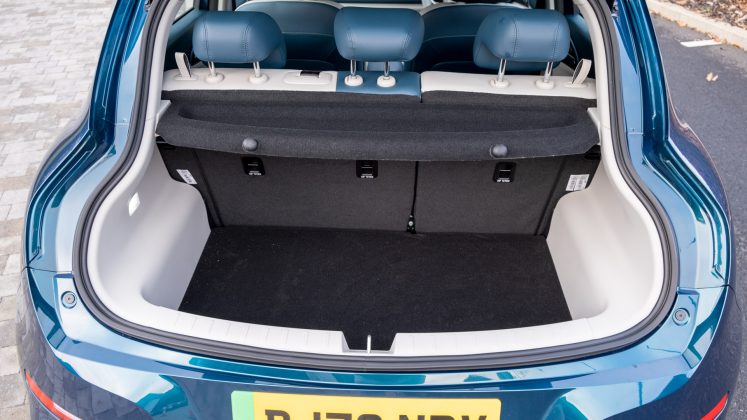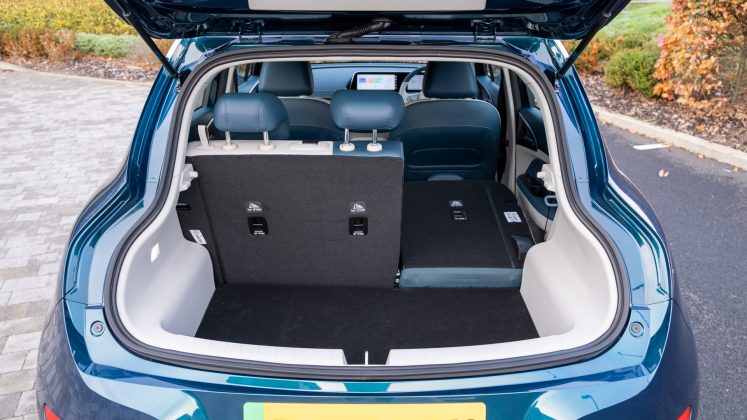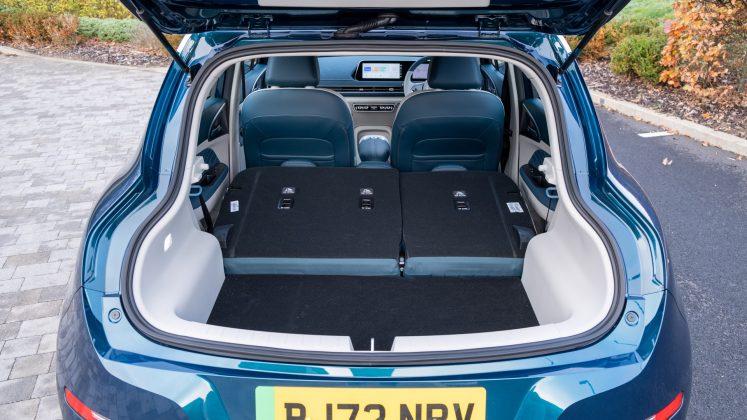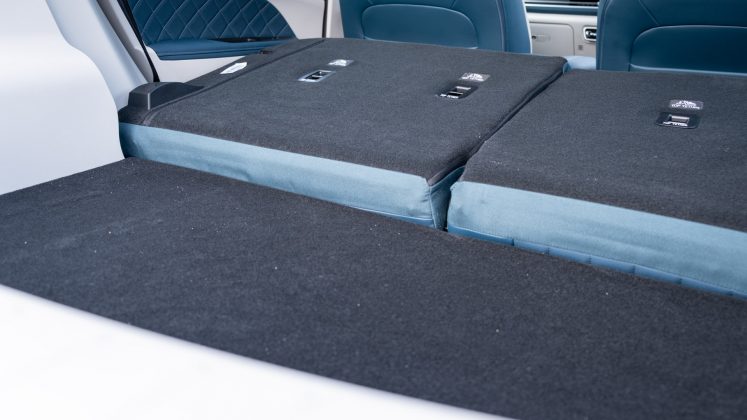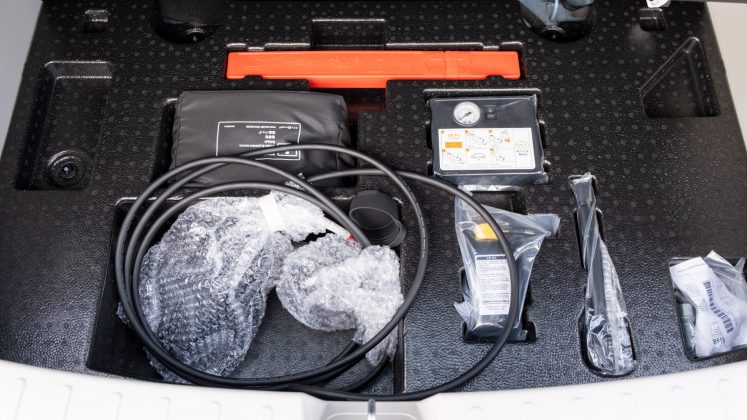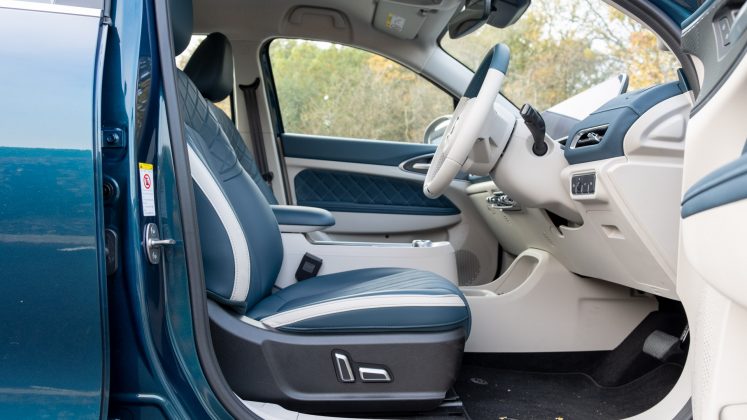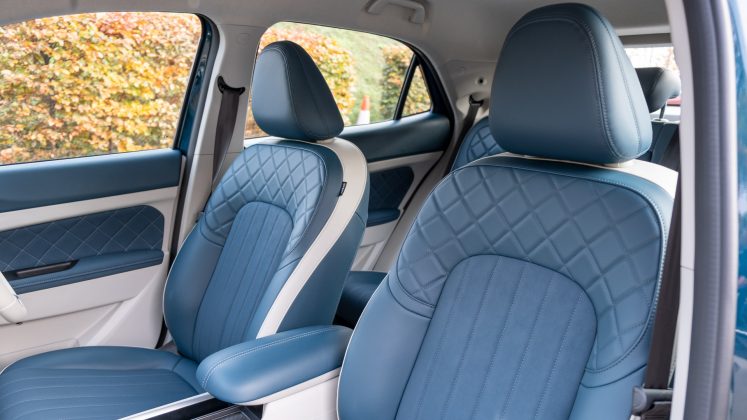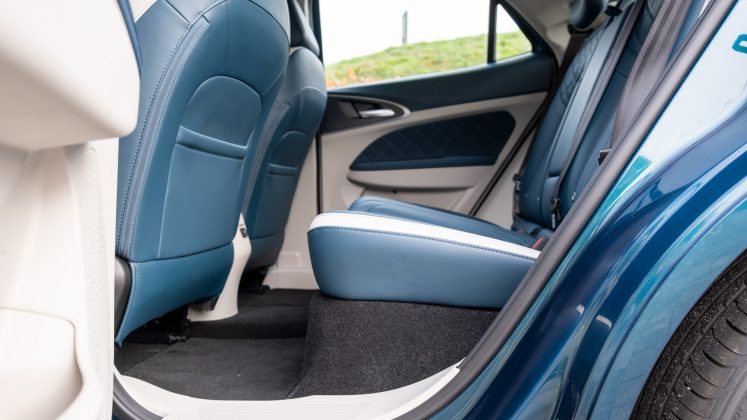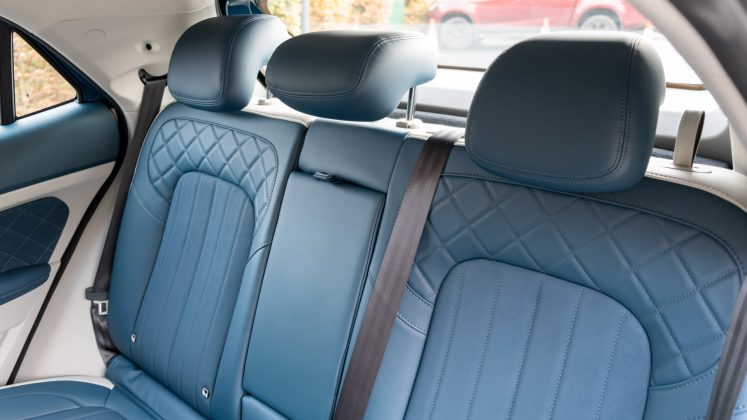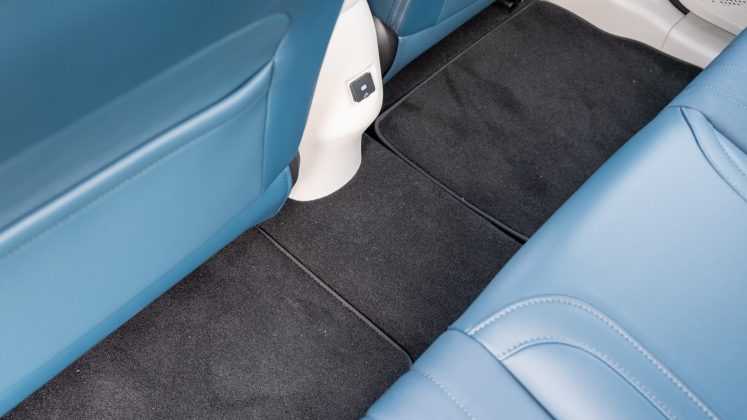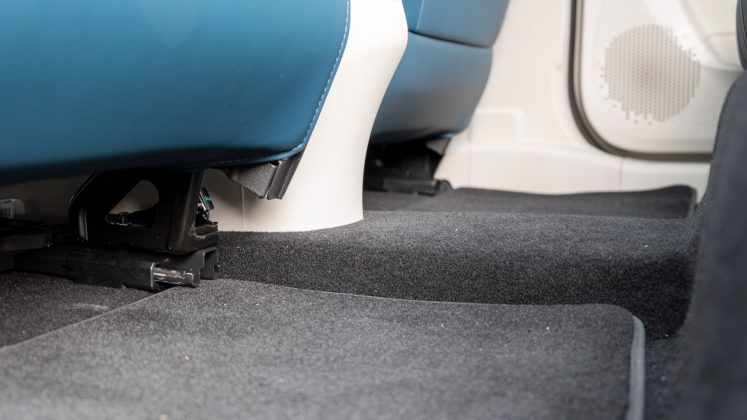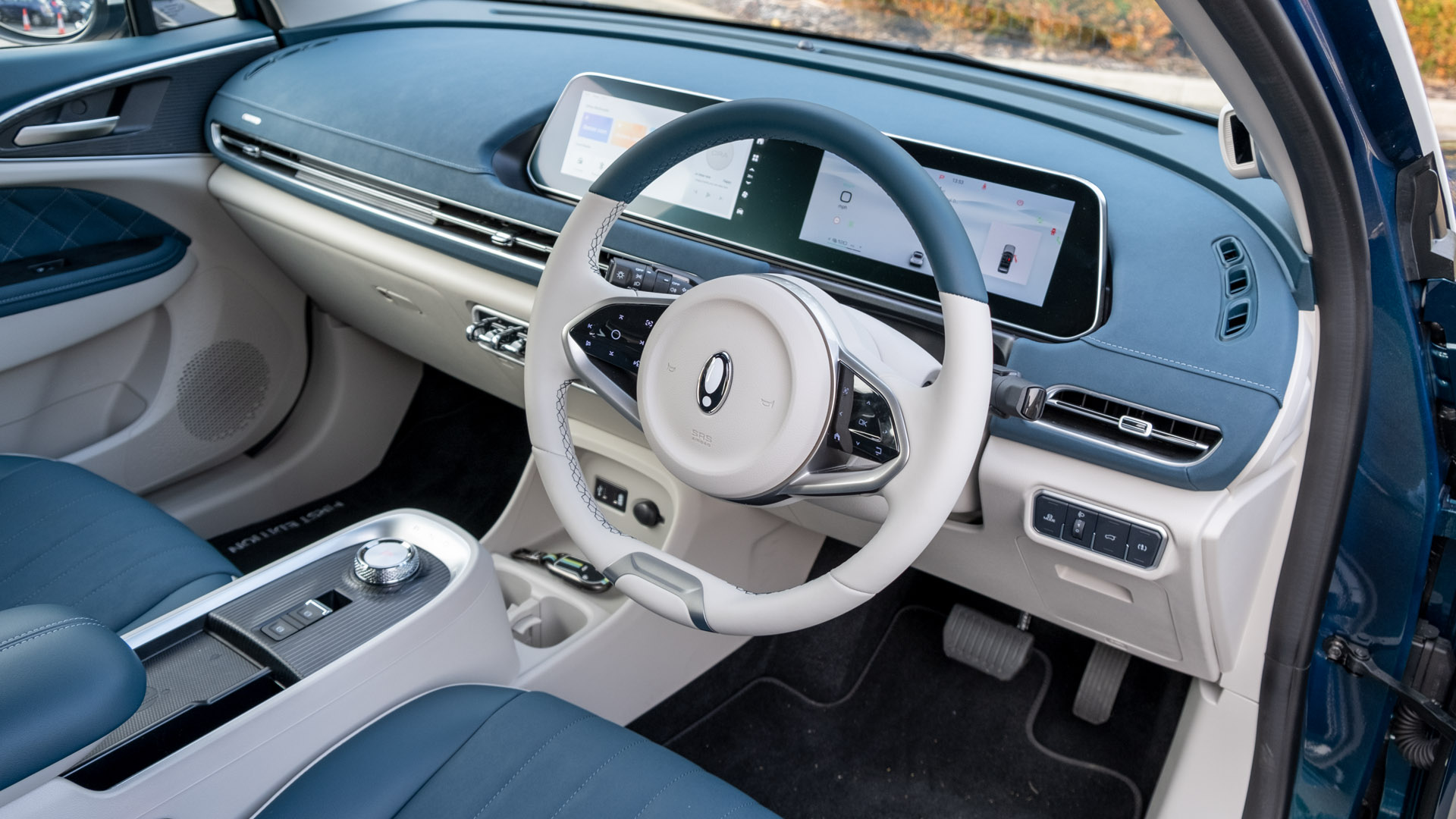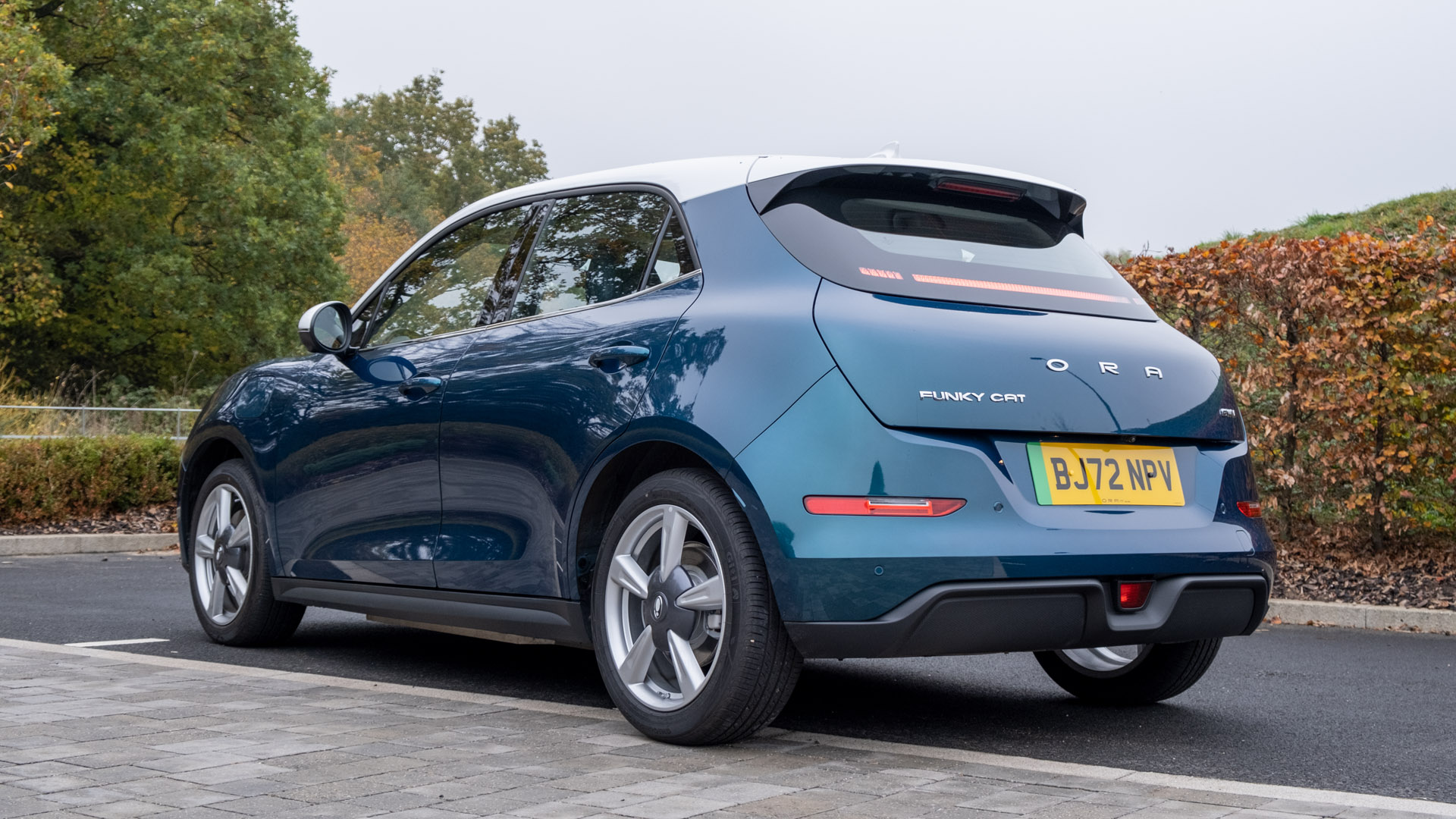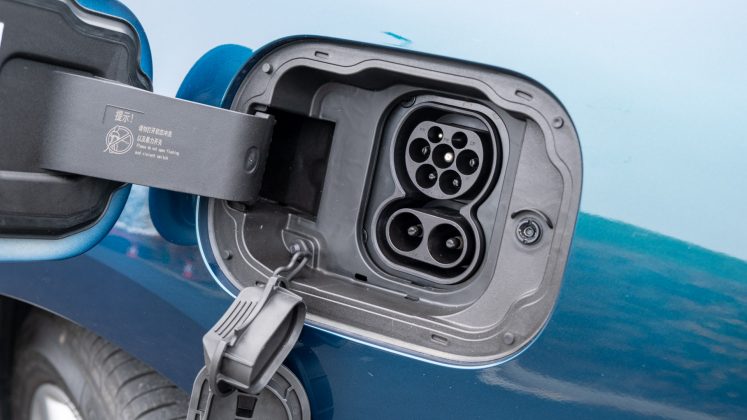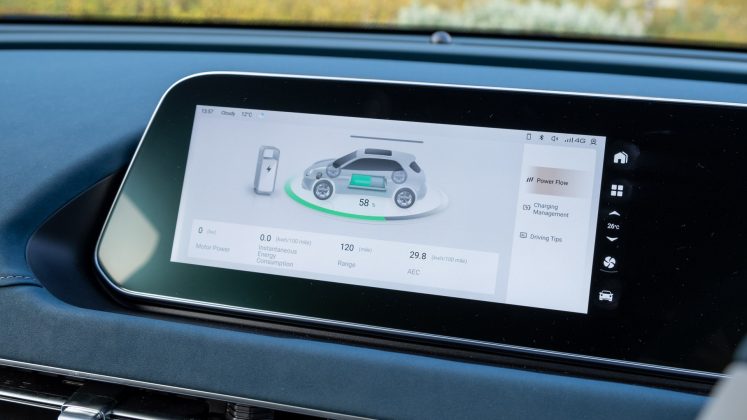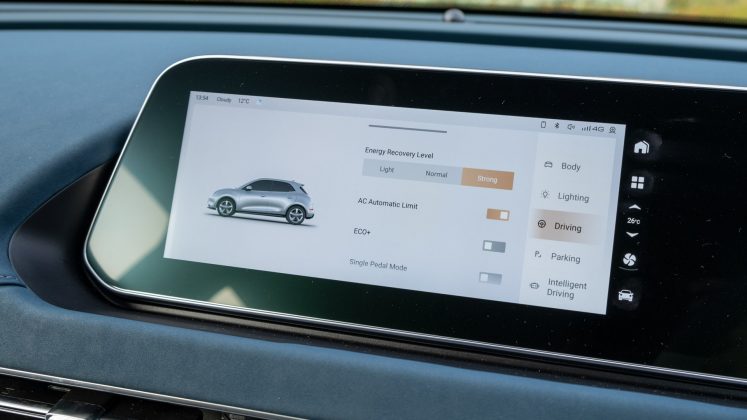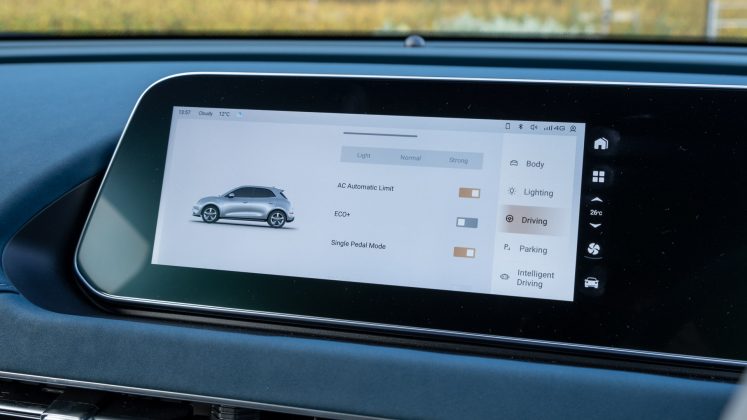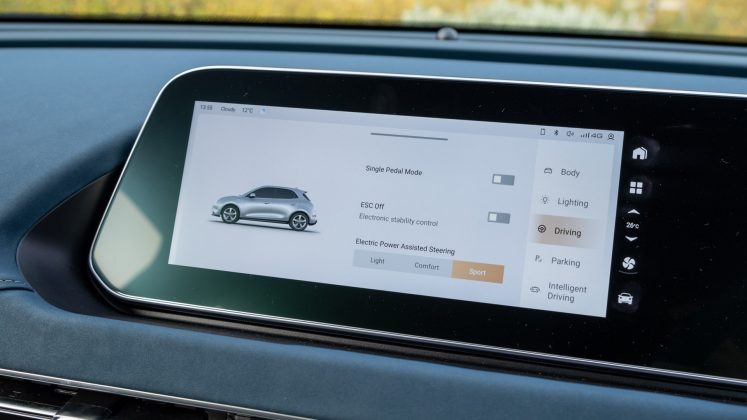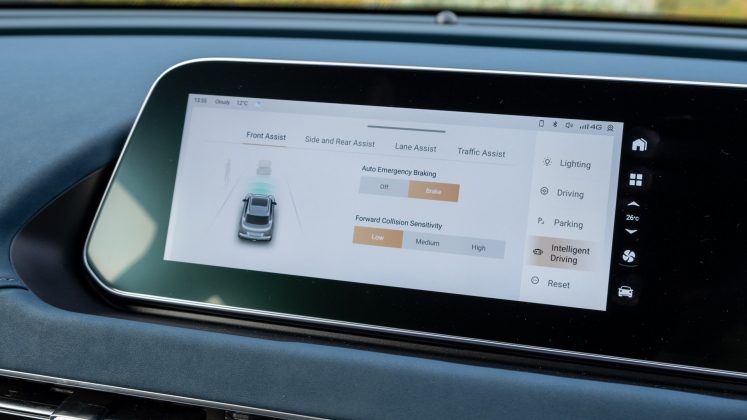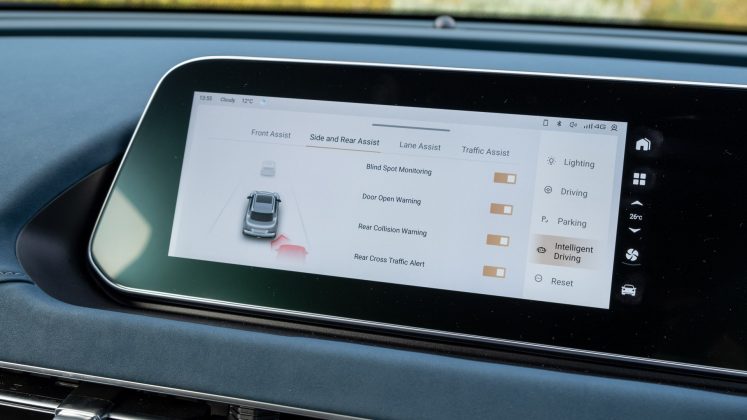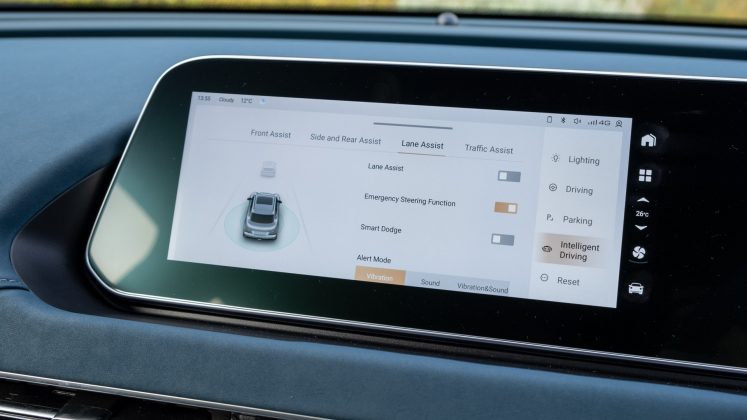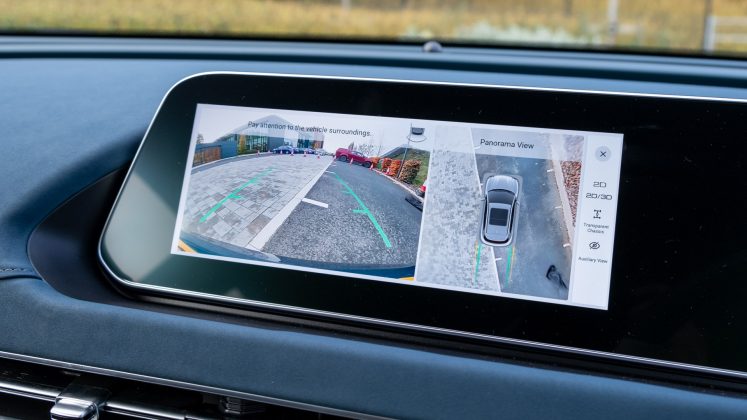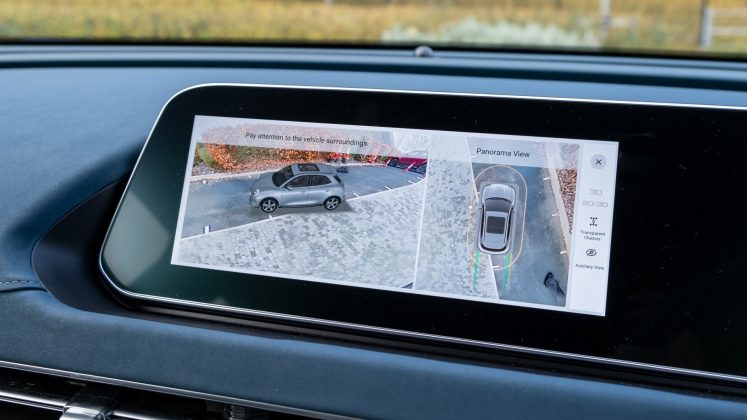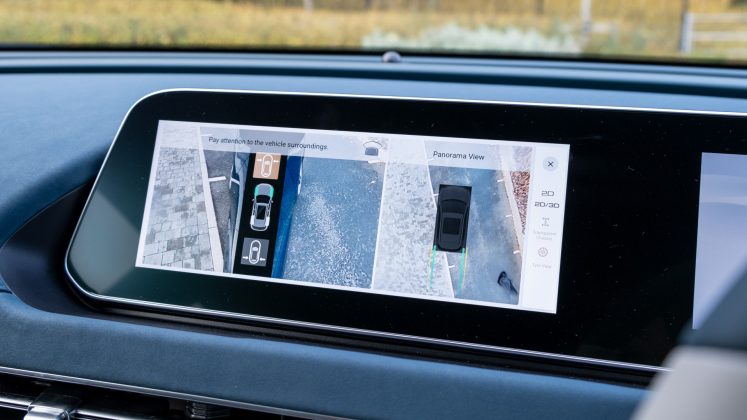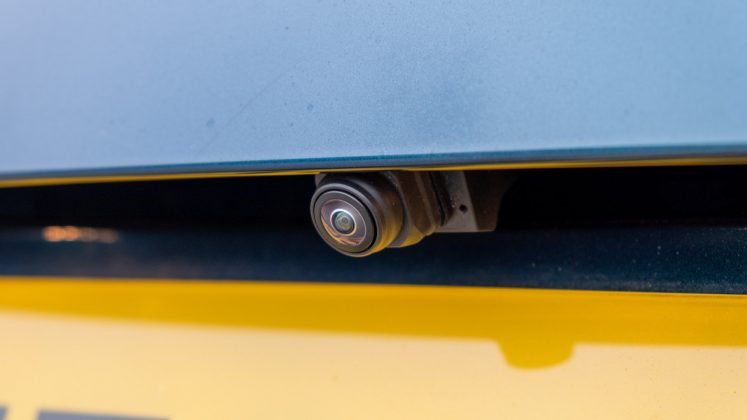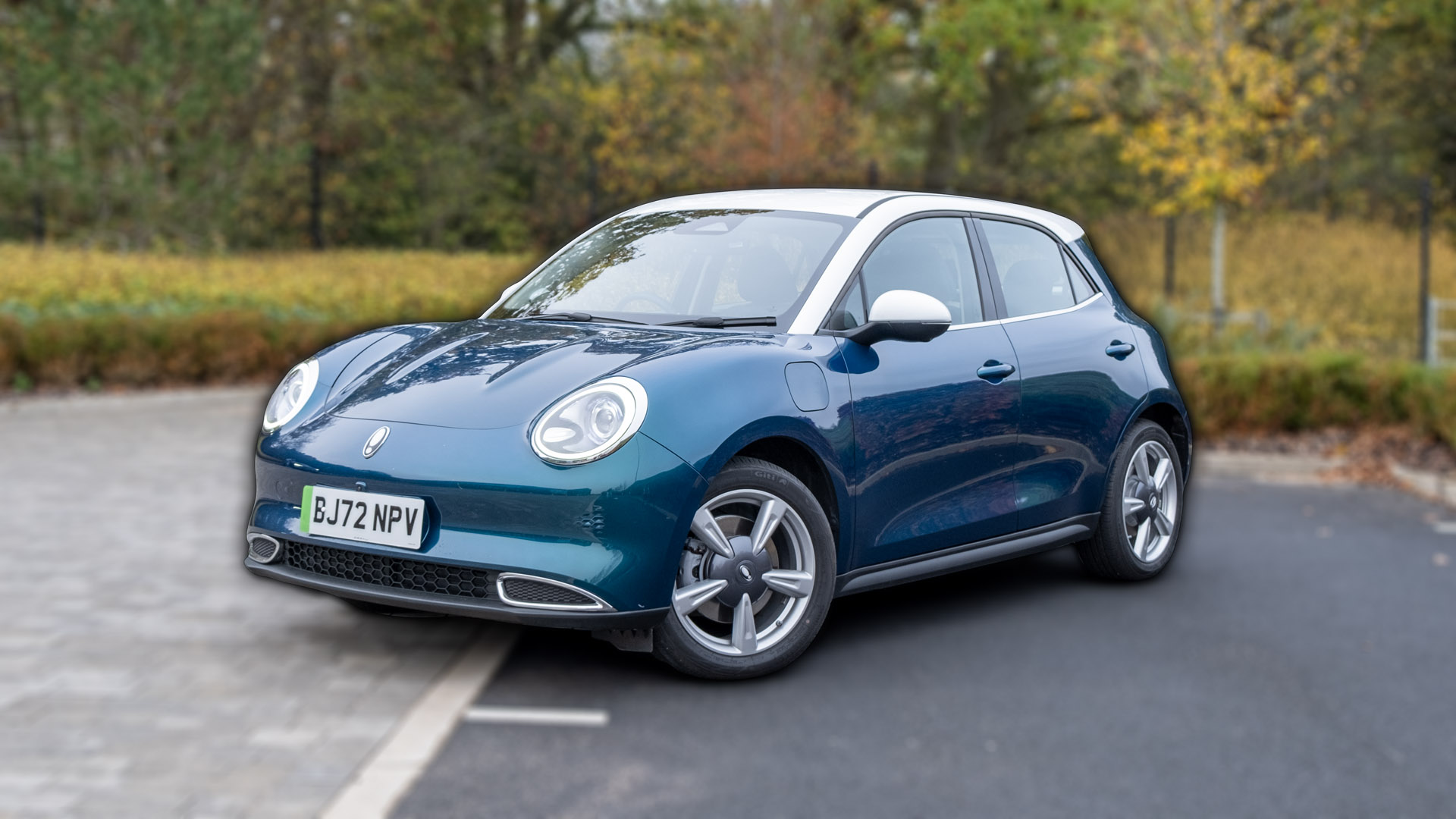The Ora 03 (once known as the Funky Cat) is a new entrant to the European and UK electric vehicle market. Manufactured by the privately-owned Chinese automaker, Great Wall Motor (GWM), Ora a subsidiary of the multi-billion pound company, is attempting to tempt prospective buyers with its unique and intriguingly named car, the 03/Funky Cat.
If you’d prefer to watch a review of the Ora 03, head on over to our YouTube channel.
GWM Ora 03 price & competition
Given GWM is not a household brand outside of China, one might think the automaker would offer its new EV at a lucrative price. Unfortunately, at the time of writing and within the UK, the First Edition model that houses a 48 kWh battery pack costs £31,995 without options. In other markets, it’s also available with a larger battery configuration.
Indeed, it does have a steep asking price, but it’s fully loaded with Advanced Driver Assistance Systems (ADAS) – below you’ll see the suite of features that come included as standard (click to expand):
What is further impressive is that the vehicle has a 5-year/unlimited mileage warranty, 8-year/100k miles EV battery and powertrain warranty, 5-year/60k miles paint warranty and a 12-year anti-corrosion warranty.
When it comes to its rivals, there are a few hatchbacks and saloons to consider: the BMW i4 from £53,4805; the Tesla Model 3 from £48,490; the Polestar 2 from £43,150; Cupra Born from £36,475; the VW ID.3 from £36,990; the Honda e from £36,920; the BMW i3 from £33,805; the Peugeot e-208 from £31,345; the Fiat 500 Electric from £30,645; the Renault Zoe from £29,995; Vauxhall Corsa-e from £29,035; the Mini Electric from £29,000; the Nissan Leaf from £28,995; the MG4 EV from £25,995; and the Smart fortwo coupé from £22,225.
Elsewhere, you might want to consider an SUV, in the more affordable segment you’ll find: the MG ZS EV from £29,495; the Citroen e-C4 from £30,995; the Hyundai Kona Electric from £31,325; the Vauxhall Mokka-e from £32,695; the Peugeot e-2008 from £33,700; the Kia Soul EV from £34,995; the Kia Niro EV ‘2 64’ from £36,245; the Volkswagen ID.4 from £37,290; and the Skoda Enyaq iV 60 from £38,380. You’ve also got the MG5 EV, the all-electric estate that starts from £30,995.
Read next: MG4 EV review: The best value EV to date
GWM Ora 03 exterior review
The vehicle’s exterior design is as its name suggests – funky. It differentiates itself from other EVs and doesn’t adopt an aggressive, sportier design. In fact, Ora’s EV reminds us of Porsche’s 1948-1965 classic, the 356. Indeed, its frontal profile has a cute bubble-shaped design, while streamlined curves stretch around the side and rear of the vehicle to provide a calming finish.
A stylish taillight design also sets the Ora 03 apart from its competitors; the LED light that resides under the rear window is a head-turner due to its unorthodox location. As for the rims, 18″ alloys (215/50 R18) come fitted as standard. In terms of your colour options, Nebula Green comes as standard. The metallic Starry Black costs an additional £595, while the Mars Red with Starry Black roof and the pictured Aurora Green with Moonlight White roof, which both have a dual-tone interior cost an extra £795.
In terms of its dimensions, it’s 4235mm long, 1825mm wide and 1603mm tall. Despite its appearance, it’s similar to the VW ID.3 and Cupra Born hatchbacks, and the Hyundai Kona Electric SUV.
It’s worth noting that there’s a ‘GT’ version of the vehicle, though, at the time of writing this has yet to come to the UK market. It has a few sportier design characteristics but is otherwise similar to the First Edition model that we have on review.
Read next: Cupra Born review: Better than the VW ID.3?
GWM Ora 03 interior review
The vehicle’s exterior design might divide opinion, but we feel most will agree that inside the cabin it’s absolutely gorgeous, especially with that two-tone finish. The choice of materials, the upholstery and the stitching work all ooze with quality. For us, it has the best-looking interior for a vehicle of its price, easily dethroning the Fiat 500 Electric.
The Ora 03’s interior is not only stunning to look at, but is also practical. A few handy physical buttons, similar to that of the Mini Electric, reside by the dashboard. A snazzy rotary gear selector resides by the centre console and controls on the steering wheel, which appear to be touch-sensitive due to their backlight, are in fact physical buttons; this prevents mistouch operations, a complaint of ours of the VW ID.3 and Cupra Born.
On the subject of practicality, the buttons on the left-hand side of the steering wheel adjust the infotainment system, while the ones on the right can alter the instrument cluster. This makes for an intuitive user experience, especially with two dedicated buttons on either side of the steering wheel being customisable. At the time of writing, your options are limited, but the automaker has assured us that a multitude of options are coming via an imminent OTA firmware update.
This leads us to the use of technology within the cabin. There are two 10.25″ displays, with the centre screen supporting multitouch input. Both are vivid, extremely fluid and intuitively laid out. Given there are no physical climate controls, rather only a shortcut via the levers found below, it’s great to see that the automaker has really optimised the user interface.
Unfortunately, however, Android Auto and Apple CarPlay are missing. TotallyEV has been informed that the third-party mobile operating systems will come via an OTA firmware update in Q1-Q2 2023. This means that at the time of writing, one can only connect a smartphone to the infotainment system via Bluetooth – the SBC and AAC codecs are supported only.
Thankfully, a one-year subscription to online services, such as Deezer, allows users to playback high-resolution music files via the punchy six-speaker audio system that uses DTS CS Auto technology to bolster its reproduction.
Aside from all this, the Ora 03 also has an app (available on the Play Store and App Store) that allows you to monitor the vehicle from afar. There’s also a facial recognition system within the cabin, which will intelligently detect the occupant in the driver’s seat and change the vehicle’s settings based on their presets – useful if you’re sharing the EV with your partner or friends.
Elsewhere, the ‘Hello Ora’ voice recognition system is pretty advanced; with the power of your voice, you can open the windows, change the climate settings or even navigate to your nearest charge point. From our tests, we found it to be extremely responsive and accurate to commands.
While there’s a real emphasis on the use of technology within the cabin, it’s a shame that there’s no Head-Up Display (HUD) available as an option.
Read next: Hyundai Kona Electric review: Kia e-Niro alternative?
GWM Ora 03 storage review
At the front of the cabin, the Ora 03 is surprisingly spacious, this is partially down to the vehicle’s interior design, which cuts away the centre console and creates a feeling of openness. Indeed, there’s a small bay under the physical buttons for loose change or your key fob, two cupholders further down and a non-slip wireless smartphone charging bay near the gear selector. As for the centre armrest compartment, it’s larger than you’d expect due to its deepened nature. The glove compartment is also optimised and provides even more areas to store your valuables away from prying eyes.
On the other hand, the door bins are a little tight – the front two will accommodate a 500ml bottle but due to design, it’s not easy to remove a bottle from the cut-out compartments. At the rear, they’re unsurprisingly smaller. Speaking of which, at the back of the cabin, if there’s no middle occupant, you’ll find two cupholders within the pulldown armrest.
As for the boot, there’s 228 litres of space with the seats up and with them down, there’s 858 litres. Here’s how it stacks up to its rivals: BMW i4 (470/1,290 litres); Nissan Leaf (435/1,161 litres); Hyundai Ioniq Electric (357/1,417 litres); Tesla Model 3 (425/1,235 litres); VW ID.3/Cupra Born (385/1,267 litres); MG4 EV (363/1,177 litres); Polestar 2 (405/1,095 litres); Renault Zoe (338/1,225 litres); Vauxhall Corsa-e (267/1,076 litres); VW e-up! (251/951 litres); Seat Mii Electric (251/923 litres); Mini Electric (211/731); Honda e (171/571 litres); Fiat 500 Electric (185/550 litres); Smart EQ Fortwo (260/360 litres).
There are also a few all-electric SUVs that unanimously trump the Ora 03: Skoda Enyaq iV (585/1,710 litres); VW ID.4 (543/1,575 litres); MG5 EV estate (464/1,456 litres); Kia e-Niro (451/1,405 litres); Peugeot e-2008 (434/1,467 litres); MG ZS EV (448/1,375 litres); Kia Soul EV (315/1,339 litres); Citroen e-C4 (380/1,250 litres); Hyundai Kona Electric (332/1,114 litres); Vauxhall Mokka-e (310/1,060 litres).
In terms of convenience, the tailgate has an excellent opening range, is easy to operate and thanks to its hatchback design, allows 6ft (182cm) individuals to easily frequent the rear of the vehicle. However, it’s manually operated and there’s no electric tailgate available as an option.
As for rear seats, they have a 60:40 rear-split folding design and when folded, the seatbelts don’t have runners to prevent them from dropping with the seats; there’s no through-loading either due to the omission of a ski latch. As for the boot floor, it’s not flat – there’s a small step, similar to that of its rivals. On the plus side, there’s an underfloor compartment that can be used to transport your charging cables. A worthwhile addition as at the front of the vehicle there’s no additional storage.
Read next: Skoda Enyaq iV review: The Volkswagen ID.4 alternative
GWM Ora 03 comfort review
The rear of the cabin might not have much storage capacity but the seats themselves are accommodating and provide good support for longer journeys. Better still, the Chinese automaker omits a transmission tunnel that allows the rear middle occupant to place their feet comfortably in front of them.
As for headroom, it’s on par with other electric hatchbacks on the market; at the rear, 6-foot 2-inch (188cm) individuals won’t feel henned in thanks to an upward-sloping roofline. Legroom at the back isn’t bad either, though, the placement of the vehicle’s battery pack does result in the seats being diagonally wedged – thankfully, this doesn’t hinder comfort as there’s plenty of room to stretch one’s legs.
At the front, both headroom and legroom are excellent, especially due to both the driver and passenger seats having electronic controls. However, they’re not heated and neither is the steering wheel.
As for cabin noise, the Ora 03 has good insulation, which helps mitigate unwanted sounds. There is a little bit of wind noise that can be heard deflecting off the A-pillars at higher speeds, but it’s minimal.
Read next: BMW i4 review: Is the i4 eDrive40 better than the i4 M50?
GWM Ora 03 performance review
What also constitutes in having a pleasant driving experience is the suspension setup and for us, GWM has nailed the execution. The vehicle absorbs anomalies, potholes and speed bumps valiantly in an urban environment, while on rural roads doesn’t suffer from any inherent body roll. Make no mistake though, it won’t compete with adaptive suspension systems found on dearer offerings.
The Ora 03 operates on a front-wheel drive (FWD) system and offers good user input – in its Sport mode driving preset, the steering feels connected to the front axle. While there’s no torque steer or front-wheel spin like you’d find on the MG ZS EV and Hyundai Kona Electric SUVs, the 1,970kg Ora can’t match the driver’s feel of its rear-wheel drive (RWD) rivals. Indeed, the BMW i4, Tesla Model 3, VW ID.3, Cupra Born and Honda e are all a lot more fun to drive. Even the Mini Electric and entry-level Polestar 2, both of which operate on an FWD system, provide a heightened driving experience.
As for performance, GWM has mounted a singular motor at the front of the vehicle. Combined with its 48 kWh battery pack, the Ora 03 outputs 126 kW (169hp) of power and 250 Nm of torque. We had it tested from 0-60mph using Racelogic’s Vbox Sport, at 7.37 seconds. Top speed is limited to 99mph. In practice, the Ora feels nippy and is plenty of fun to drive around town – it won’t compete with dual-motor setups or sportier alternatives, but we suspect the target market of the Ora 03 won’t be too concerned.
What will be of importance, however, is its electric range. Here, the automaker claims the 48 kWh variant that we have on review will run for 193 miles without having to stop. In our mixed driving tests, we netted a very respectful figure of 140-160 miles, which is identical to what we achieved in the Fiat 500 Electric.
Compared to a few more of its rivals, the Ora 03 will go further than the Vauxhall Corsa-e (130-140 miles), the Mini Electric (100-110 miles), and thumps the Honda e (80-90 miles) and Smart EQ Fortwo (70-75 miles).
However, the single-motor Polestar 2 achieved 250-270 miles, the BMW i4 eDrive40 240-260 miles, the entry-level Tesla Model 3 230-250 miles, the MG4 EV Long Range 220-240 miles, the VW ID.3 230 miles, the Cupra Born 210-220 miles, the Nissan Leaf Tekna e+ and Renault Zoe R135 both at 200 miles, while few of the more affordable electric SUVs, such as the Kia Soul EV, Kia e-Niro, Hyundai Kona Electric and heat pump-less VW ID.4, achieved north of 260 miles. Effectively, quite a few of its competitors offer better range for near-enough the same price.
Buy a car phone mount on Amazon (Affiliate)
Its electric range isn’t class-leading, however, the option to enable Single Pedal Mode is certainly appreciated within the city. In said mode, one can decelerate the vehicle to a complete standstill and recoup; as much energy back into the battery pack via regenerative braking.
We should point out that Single Pedal Mode, which can be selected through the infotainment system, overrides the vehicle’s driving mode – it’s as if it’s a mode in its own right. This odd behaviour isn’t something we’ve noted in any other vehicle that we’ve tested to date, whereby selecting said feature would keep you in Normal/Sport/Eco modes – that’s not the case in the Ora 03, with the drive mode disappearing from the instrument cluster.
There are of course other regenerative braking modes – Light, Normal and Strong – that serve as a global setting for all drive modes. We’d have liked to see the Energy Recovery Levels linked to the different drive modes, with Single Pedal Mode used in tandem.
To recharge the vehicle, the CCS charging port supports up to 64 kW of input. This allows you to go from 15-80% on an appropriate charger in 42.5 minutes. As for its Type 2 port, it’s capable of taking up to 11 kW, allowing it to recharge to 80% in 3hrs 12 mins. A single-phase 7 kW charger will take 5hrs 24mins, while a home 3-pin wall plug will take significantly longer.
Read next: Tesla Model 3 review (2021 facelift): Should you buy into the hype?
GWM Ora 03 safety review
Despite all its competencies and flaws, what really stands out for us is the vehicle’s safety credentials. It scored 5/5 stars on Euro NCAP’s rigorous crash tests, scoring 92% in Adult Occupancy, 83% in Child Occupancy and a whopping 93% in Safety Assist, the latter being the fifth-highest score ever recorded on the assessment programme.
Indeed, the plethora of Advanced Driver Assistance Systems (ADAS) that come fitted as standard on the Ora 03 First Edition are impressive: Blindspot Detection (BD), Lane Change Assist (LCA), intelligent Fatigue Monitoring, Adaptive Cruise Control (ACC) with ‘Stop & Go’ Function, Lane Keep Assist (LKA), Lane Centring Function (LCF), Rear Traffic Cross Alert & Brake, Auto Emergency Braking, With Pedestrian & Cyclist Detection (AEB, AEB-P/B), Junction Assist (AEB-JA), and Traffic Sign Recognition.
In our tests, we found ACC, LKA, LCF, LCA and BD to be absolutely stellar. Namely the former system that smoothly regulated the distance from the leading vehicle. Our only complaint was the Traffic Sign Recognition system, which often got the wrong speed limit.
Moving onto visibility, there are no issues at the front or side, though at the rear it’s a little limited due to the design of the window. Thankfully, Ora provides phenomenal high-resolution 360-degree cameras as standard with front and rear parking sensors – parking is a breeze, and with front and rear tyre cameras, you won’t fear curbing those 18″ alloys either. As for the vehicle’s turning circle, it’s rated at 11.2 metres.
Read next: Polestar 2 review: Tesla Model 3 and BMW i4 beater?
TotallyEV’s verdict on the Ora 03
GWM’s Ora 03 is an accomplished new electric vehicle that offers class-leading interior design, ADAS and clever technology within the cabin. It offers good driving dynamics, a quirky exterior design and a usable boot.
However, these qualities come with a premium price tag, and given the vehicle hasn’t got the best electric range and misses out on a few features, it might prove to be a tough sell for consumers looking to buy a new EV. Nonetheless, TotallyEV still recommends shortlisting the Ora 03.
Would you choose Ora’s small EV over its rivals? Let us know in the comments section below or via social media; we’re on: YouTube, Instagram, Facebook, Twitter and LinkedIn.

